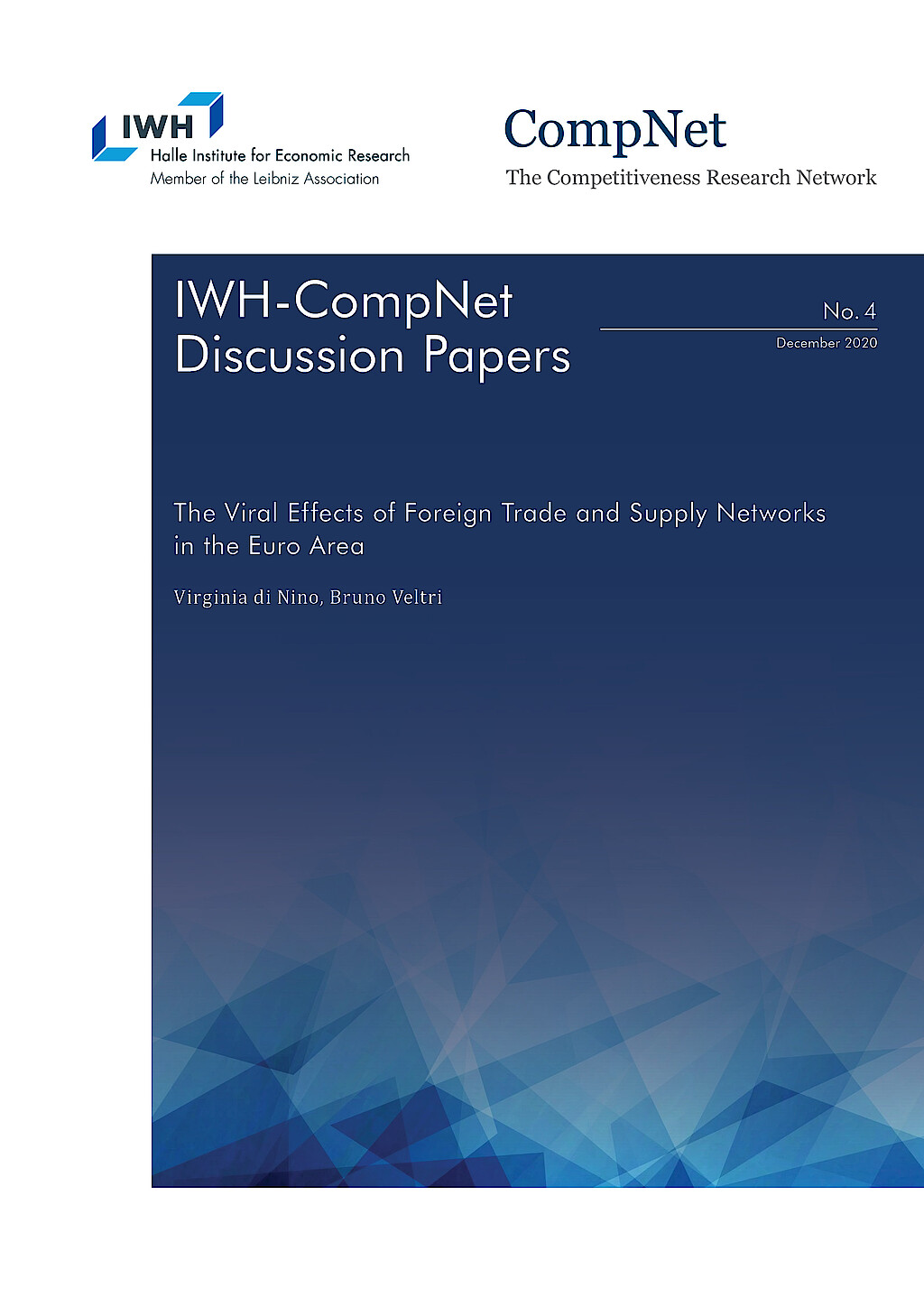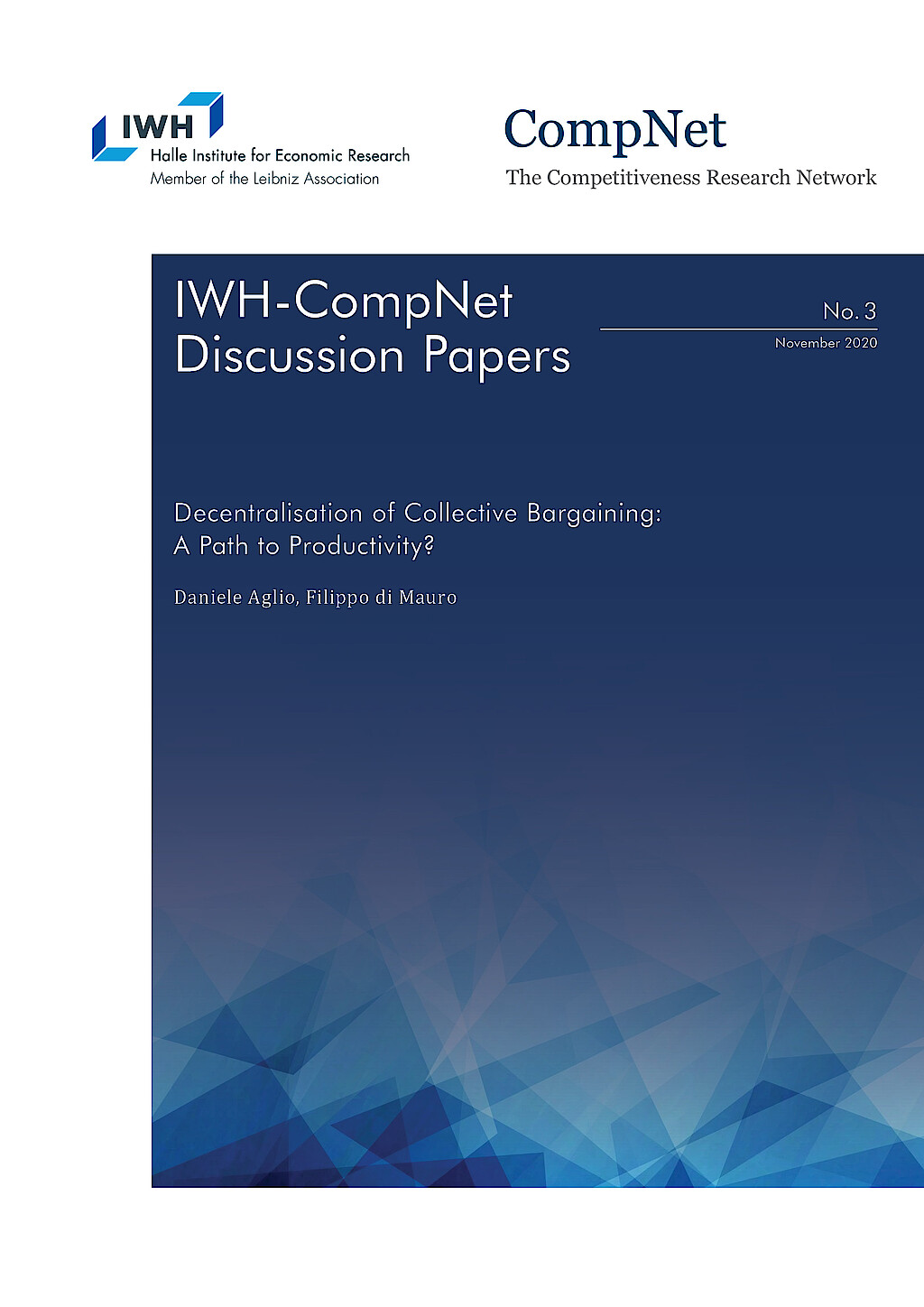IWH-CompNet Discussion Papers
Die IWH-CompNet Discussion Papers beinhalten Forschungsergebnisse auf Basis von Daten zur Produktivität, die durch das Competitiveness Research Network (CompNet) bereitgestellt werden. Das internationale Netzwerk verfolgt das Ziel, einen einheitlichen Analyserahmen zu entwickeln, mit dessen Hilfe Produktivität und Wettbewerbsfähigkeit eingeschätzt werden können. Die Papiere ermöglichen den Zugang zu den Forschungsergebnissen von CompNet in einer vorläufigen Fassung, zu der Kommentare und Empfehlungen vor der endgültigen Veröffentlichung gern angenommen werden.
Aktuelle Ausgaben

Benchmarking New Zealand's Frontier Firms
in: IWH-CompNet Discussion Papers, Nr. 1, 2021
Abstract
New Zealand has experienced poor productivity performance over the last two decades. Factors often cited as reasons behind this are the small size of the domestic market and distance to international partners and markets. While the distance reason is one that is fairly insurmountable, there are a number of other small advanced economies that also face similar domestic market constraints. This study compares the relative performance of New Zealand’s firms to those economies using novel cross-country microdata from CompNet. We present stylised facts for New Zealand relative to the economies of Belgium, Denmark, Finland, Netherlands and Sweden based on average productivity levels, as well as benchmarking laggard, median and frontier firms. This research also employs an analytical framework of technology diffusion to evaluate the extent of productivity convergence, and the impact of the productivity frontier on non-frontier firm performance. Additionally, both labour and capital resource allocation are compared between New Zealand and the other small advanced economies. Results show that New Zealand’s firms have comparatively low productivity levels and that its frontier firms are not benefiting from the diffusion of best technologies outside the nation. Furthermore, there is evidence of labour misallocation in New Zealand based on less labour-productive firms having disproportionally larger employment shares than their more productive counterparts. Counter-factual analysis illustrates that improving both technology diffusion from abroad toward New Zealand’s frontier firms, and labour allocation across firms within New Zealand will see sizable productivity gains in New Zealand.

The Viral Effects of Foreign Trade and Supply Networks in the Euro Area
in: IWH-CompNet Discussion Papers, Nr. 4, 2020
Abstract
Containment measures of COVID-19 have generated a chain of supply and demand shocks around the globe with heterogeneous fallout across industries and countries. We quantify their transmission via foreign trade with a focus on the euro area where deep firms integration within regional supply chains and strong demand linkages act as a magnification mechanism. We estimate that spillover effects in the euro area from suppression measures in one of the five main euro area countries range between 15-28% the size of the original shock; negative foreign demand shocks depress euro area aggregate activity by about a fifth the size of the external shock and a fourth of the total effect is due to indirect propagation through euro area supply chain. Last, reopening to regional tourism softened the contraction of aggregate activity due to travel and tourism bans by about a third in the euro area. Our findings suggest that enhanced coordination of recovery plans would magnify their beneficial effects.

Decentralisation of Collective Bargaining: A Path to Productivity?
in: IWH-CompNet Discussion Papers, Nr. 3, 2020
Abstract
Productivity developments have been rather divergent across EU countries and particularly between Central Eastern Europe (CEE) and elsewhere in the continent (non-CEE). How is such phenomenon related to wage bargaining institutions? Starting from the Great Financial Crisis (GFC) shock, we analyse whether the specific set-up of wage bargaining prevailing in non-CEE may have helped their respective firms to sustain productivity in the aftermath of the crisis. To tackle the issue, we merge the CompNet dataset – of firm-level based productivity indicators – with the Wage Dynamics Network (WDN) survey on wage bargaining institutions. We show that there is a substantial difference in the institutional set-up between the two above groups of countries. First, in CEE countries the bulk of the wage bargaining (some 60%) takes place outside collective bargaining schemes. Second, when a collective bargaining system is adopted in CEE countries, it is prevalently in the form of firm-level bargaining (i. e. the strongest form of decentralisation), while in non-CEE countries is mostly subject to multi-level bargaining (i. e. an intermediate regime, only moderately decentralised). On productivity impacts, we show that firms’ TFP in the non-CEE region appears to have benefitted from the chosen form of decentralisation, while no such effects are detectable in CEE countries. On the channels of transmission, we show that decentralisation in non-CEE countries is also negatively correlated with dismissals and with unit labour costs, suggesting that such collective bargaining structure may have helped to better match workers with firms’ needs.

Trade, Misallocation, and Capital Market Integration
in: IWH-CompNet Discussion Papers, Nr. 8, 2019
Abstract
I study how cross-country capital market integration affects the gains from trade in a model with financial frictions and heterogeneous, forward-looking firms. The model predicts that misallocation among exporters increases as trade barriers fall, even as misallocation decreases in the aggregate. The reason is that financially constrained productive exporters increase their production only marginally, while unproductive exporters survive for longer and increase their size. Allowing capital inflows magnifies misallocation, because unproductive firms expand even more, leading to a decline in aggregate productivity. Nevertheless, under integrated capital markets, access to cheaper capital dominates the adverse effect on productivity, leading to higher output, consumption and welfare than under closed capital markets. Applied to the period of European integration between 1992 and 2008, I find that underdeveloped sectors experiencing higher export exposure had more misallocation of capital and a higher share of unproductive firms, thus the data is consistent with the model’s predictions. A key implication of the model is that TFP is a poor proxy for consumption growth after trade liberalisation.

Private Debt, Public Debt, and Capital Misallocation
in: IWH-CompNet Discussion Papers, Nr. 7, 2019
Abstract
Does finance facilitate efficient allocation of resources? Our aim in this paper is to find out whether increases in private and public indebtedness affect capital misallocation, which is measured as the dispersion in the return to capital across firms in different industries. For this, we use a novel dataset containing industrylevel data for 18 European countries and control for different macroeconomic indicators as potential determinants of capital misallocation. We exploit the within-country variation across industries in such indicators as external finance dependence, technological intensity, credit constraints and competitive structure, and find that private debt accumulation disproportionately increases capital misallocation in industries with higher financial dependence, higher R&D intensity, a larger share of credit-constrained firms and a lower level of competition. On the other hand, we fail to find any significant and robust effect of public debt on capital misallocation within our country-sector pairs. We believe the distortionary effects of private debt found in our analysis needs a deeper theoretical investigation.



